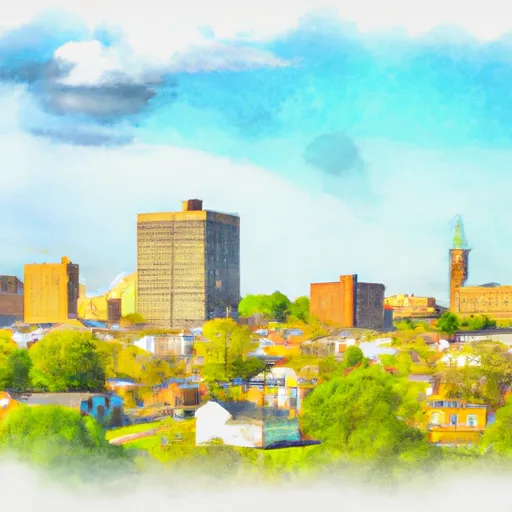-
 Snoflo Premium
Snoflo Premium
Get unlimited access to all our content
With no Ad interruptions! - Start Your Free Trial Login with existing account
West-Middletown
Eden Index
Climate
8.1
•
Recreation
2.8
•
Community
2.1
•
Safeguard
4.7/10

West-Middletown, Pennsylvania, is a charming small town located in Washington County. The climate in this region is characterized by warm summers and cold winters. Average temperatures range from the high 70s°F (25°C) in summer to the low 30s°F (-1°C) in winter, with occasional snowfall. The area experiences moderate rainfall throughout the year.
Hydrologically, West-Middletown benefits from its proximity to nearby streams and rivers, making it a scenic location. The town lies within the Ohio River watershed, which provides opportunities for water-based activities such as fishing, boating, and kayaking. The nearby Ten Mile Creek is a favorite spot for anglers seeking trout, bass, and catfish.
In terms of outdoor recreation, West-Middletown offers several options. The surrounding countryside provides ample opportunities for hiking, biking, and camping. Nearby state parks, such as Raccoon Creek State Park, offer extensive trails for nature enthusiasts. Additionally, golf courses and sports fields are available for those seeking more organized outdoor activities.
Overall, West-Middletown's pleasant climate, hydrology constituents, and diverse outdoor recreation opportunities make it an attractive destination for nature lovers and outdoor enthusiasts.
What is the Eden Index?
The Snoflo Eden Index serves as a comprehensive rating system for regions, evaluating their desirability through a holistic assessment of climate health, outdoor recreation opportunities, and natural disaster risk, acknowledging the profound impact of these factors on livability and well-being.
Climate Health Indicator (CHI): 8.1
West-Middletown receives approximately
1040mm of rain per year,
with humidity levels near 83%
and air temperatures averaging around
11°C.
West-Middletown has a plant hardyness factor of
6, meaning
plants and agriculture in this region thrive during a short period during spring and early summer. Most
plants will die off during the colder winter months.
By considering the ideal temperature range, reliable water supplies, clean air, and stable seasonal rain or snowpacks, the Climate Health Indicator (CHI) underscores the significance of a healthy climate as the foundation for quality living.
A healthy climate is paramount for ensuring a high quality of life and livability in a region, fostering both physical well-being and environmental harmony. This can be characterized by ideal temperatures, reliable access to water supplies, clean air, and consistent seasonal rain or snowpacks.
Weather Forecast
Streamflow Conditions
Upper Ohio-Beaver
Area Rivers
Upper Ohio-Beaver
Snowpack Depths
Upper Ohio-Beaver
Reservoir Storage Capacity
Upper Ohio-Beaver
Groundwater Levels
Recreational Opportunity Index (ROI): 2.8
The Recreational Opportunity Index (ROI) recognizes the value of outdoor recreational options, such as parks, hiking trails, camping sites, and fishing spots, while acknowledging that climate plays a pivotal role in ensuring the comfort and consistency of these experiences.
Access to outdoor recreational opportunities, encompassing activities such as parks, hiking, camping, and fishing, is crucial for overall well-being, and the climate plays a pivotal role in enabling and enhancing these experiences, ensuring that individuals can engage in nature-based activities comfortably and consistently.
Camping Areas
| Campground | Campsites | Reservations | Toilets | Showers | Elevation |
|---|---|---|---|---|---|
| Beaver Creek State Park | 50 | 875 ft | |||
| Stonewall Jackson State Park | None | 1,128 ft | |||
| Raccoon Creek State Park | None | 1,039 ft | |||
| Jamestown - Pymatuning State Park | 331 | 1,017 ft | |||
| Shenango | None | 934 ft | |||
| Tomlinson Run State Park | None | 945 ft |
Nearby Ski Areas
Catastrophe Safeguard Index (CSI):
The Catastrophe Safeguard Index (CSI) recognizes that natural disaster risk, encompassing floods, fires, hurricanes, and tornadoes, can drastically affect safety and the overall appeal of an area.
The level of natural disaster risk in a region significantly affects safety and the overall livability, with climate change amplifying these risks by potentially increasing the frequency and intensity of events like floods, fires, hurricanes, and tornadoes, thereby posing substantial challenges to community resilience and well-being.
Community Resilience Indicator (CRI): 2.1
The Community Resilience Indicator (CRI) recognizes that education, healthcare, and socioeconomics are crucial to the well-being of a region. The CRI acknowledges the profound impact of these elements on residents' overall quality of life. By evaluating educational resources, healthcare accessibility, and economic inclusivity, the index captures the essential aspects that contribute to a thriving community, fostering resident satisfaction, equity, and social cohesion.

